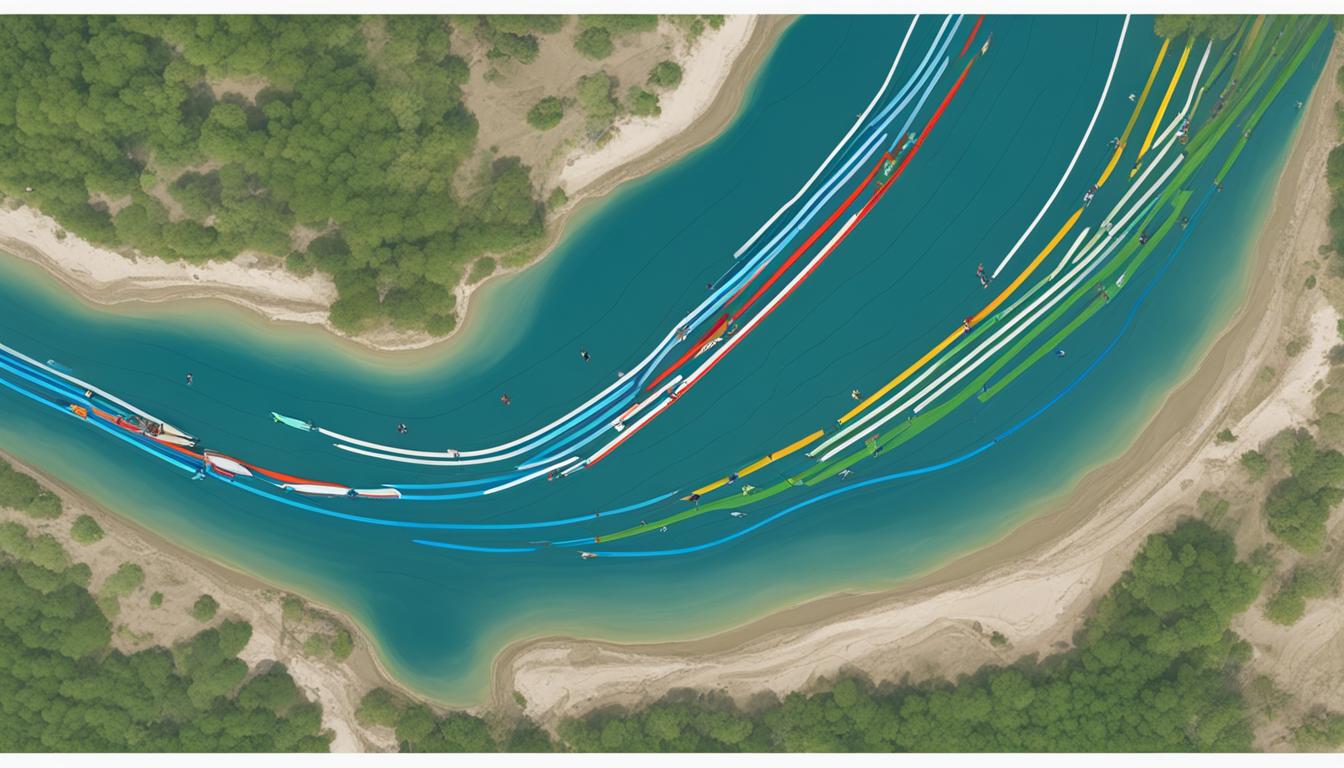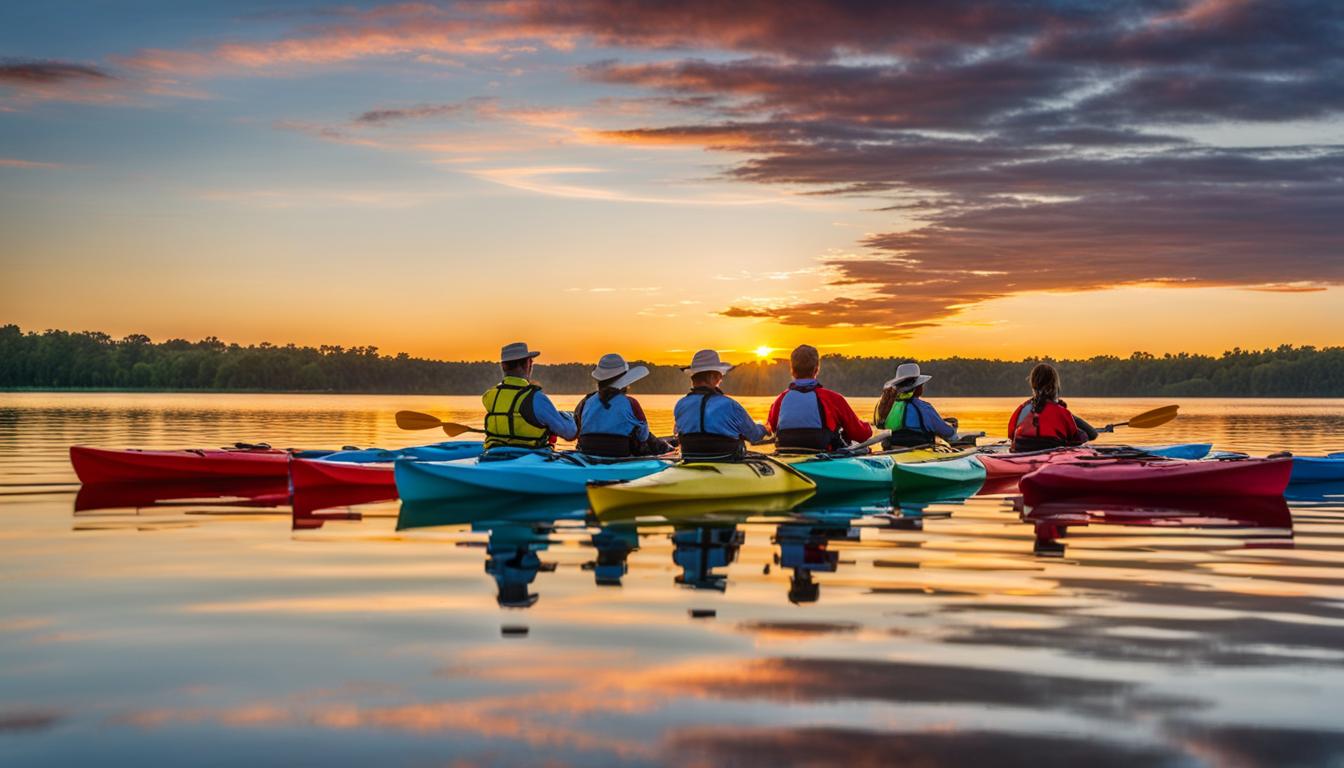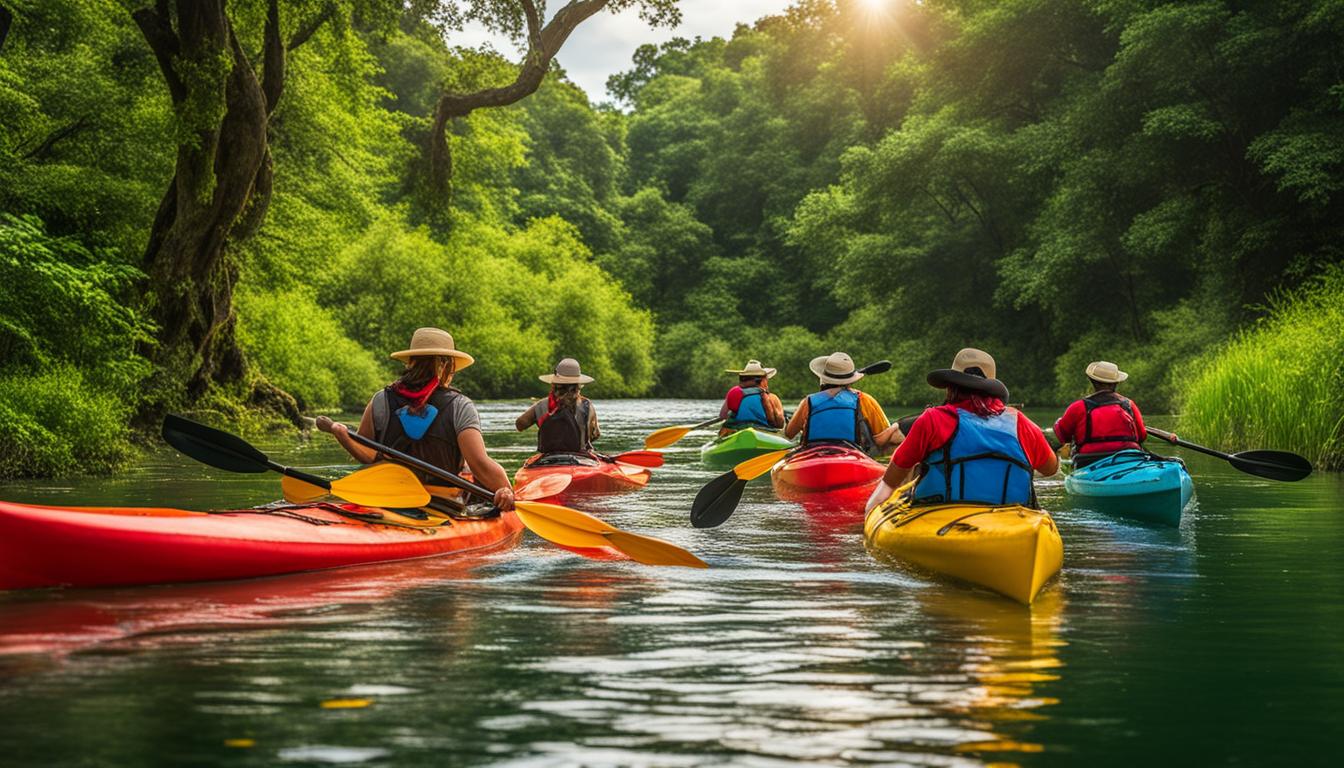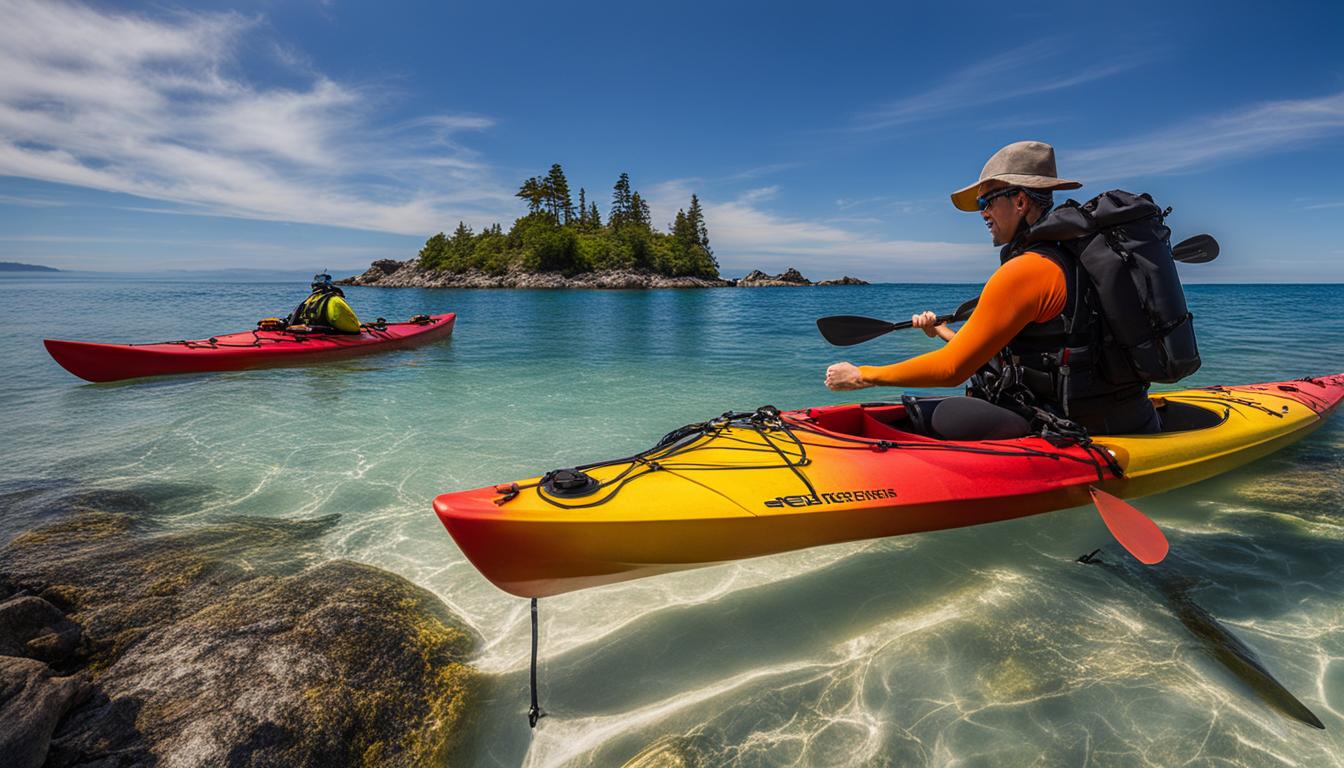Do you love kayaking? The slow pace, the stunning scenery – it’s easy to fall in love with this sport. But to make the most of your kayak trips, it’s essential to plan your paddling distances and daily goals. You want to have a great experience without overexerting yourself. However, estimating how far you can paddle in a day can be challenging. It depends on factors like your strength, stamina, kayak type, and gear weight. But don’t worry, we’ve got you covered!
In this article, we’ll explore the factors that impact kayak speed and distance, how to estimate your kayak travel distance, and tips for planning your trip. By understanding these key points, you’ll be able to plan your kayak adventures with confidence and maximize your paddling distances.
Key Takeaways:
- Estimating your paddling distance is essential for a successful kayak trip.
- Factors like wind, waves, kayak weight, and personal fitness level affect kayak speed and distance.
- Effort measurement can help you estimate your kayaking distance.
- Professional kayakers can cover impressive distances, but the average person can paddle 8-17 miles per day.
- Weather conditions, such as wind and waves, significantly impact kayak distance.
Factors That Impact Kayak Speed and Distance
When planning a kayak trip, it’s important to consider the factors that can impact your speed and distance on the water. By understanding these factors, you can better prepare and set realistic goals for your journey.
Wind Direction and Water Conditions
Wind direction plays a significant role in determining your kayak speed. A tailwind can provide a helpful push, making it easier to paddle and increasing your speed. Conversely, a headwind can create resistance, making it more challenging to move forward. It’s important to check the weather forecast before your trip and take wind direction into account when planning your route.
Water conditions, particularly waves, also affect kayak speed. Larger waves require more effort to paddle through, slowing you down. When estimating your distance, consider the wave conditions on the water and adjust your expectations accordingly.
Kayak Weight and Personal Fitness
The weight of your kayak can impact both speed and stability. Heavier kayaks sit deeper in the water, which can slow you down on flat water. However, they may offer greater stability in rough water. Lighter kayaks, on the other hand, tend to be faster but may be less stable in challenging conditions. When choosing a kayak, consider the weight and how it aligns with your desired speed and stability.
In addition to kayak weight, your personal fitness and endurance levels are crucial factors in determining how far you can paddle. Building up your fitness and focusing on endurance training can help you tackle longer distances. It’s important to set realistic goals based on your current fitness level and gradually increase your paddling distance as you build strength and stamina.
Estimating Kayak Travel Distance
When planning a kayak trip, it’s important to have a clear estimate of the distance you can cover. By using the Effort measurement, you can calculate an approximate kayaking distance. Effort is measured in miles per hour (MpH) multiplied by a variable percentage. The percentage varies based on your effort level, with light effort being around 33% of your maximum speed, medium effort around 50%, and high effort around 67%.
To estimate your kayaking distance, multiply your effort level by the number of hours you plan to paddle. For example, if you’re paddling with minimal effort for 3 hours on an 11-foot kayak, your estimated distance would be 5.1 miles.
It’s important to note that this estimation is based on average conditions and individual capabilities. Factors such as wind speed, waves, and personal fitness level can affect your actual paddling distance. However, using the Effort measurement provides a useful guideline for planning your kayak trips and setting realistic goals.
| Effort Level | Percentage |
|---|---|
| Light | 33% |
| Medium | 50% |
| High | 67% |
Keep in mind that these percentages are not fixed and can vary depending on your personal fitness level and the specific conditions of your kayak trip. It’s always advisable to start with shorter distances and gradually increase your paddling goals as you gain experience and confidence.
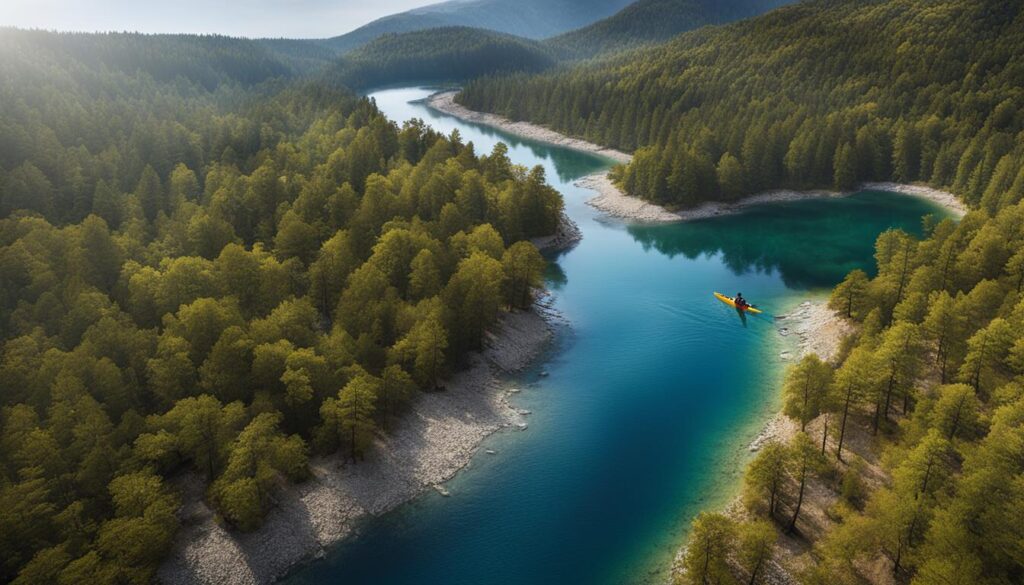
Maximum Kayaking Distances
When it comes to long-distance kayak trips, professional kayakers demonstrate impressive capabilities. Male professionals can reach up to 160 miles on flat water, while female professionals can cover distances of up to 125 miles. However, it is important to note that these are exceptional cases and not the average for the everyday kayaker. The distance you can cover in a day depends on various factors, including your physical condition, environmental conditions, and the type of water you are paddling.
For the average person, a realistic range for daily kayak distances is between 8 to 17 miles. This range takes into account factors such as wind, waves, and the type of water being paddled. It’s important to set realistic goals based on your own capabilities and the conditions you’ll be facing. Remember that factors like wind direction and strength can either assist or hinder your progress, so it’s crucial to plan accordingly.
To help you understand the range of distances you can cover, consider the following table:
| Physical Condition | Estimated Distance Range (Per Day) |
|---|---|
| Beginner/Intermediate | 8-12 miles |
| Advanced | 12-17 miles |
These estimated distance ranges are based on average physical conditions and assume moderate weather conditions. Keep in mind that your personal fitness level, kayak type, and endurance will also play a significant role in determining how far you can paddle in a day.
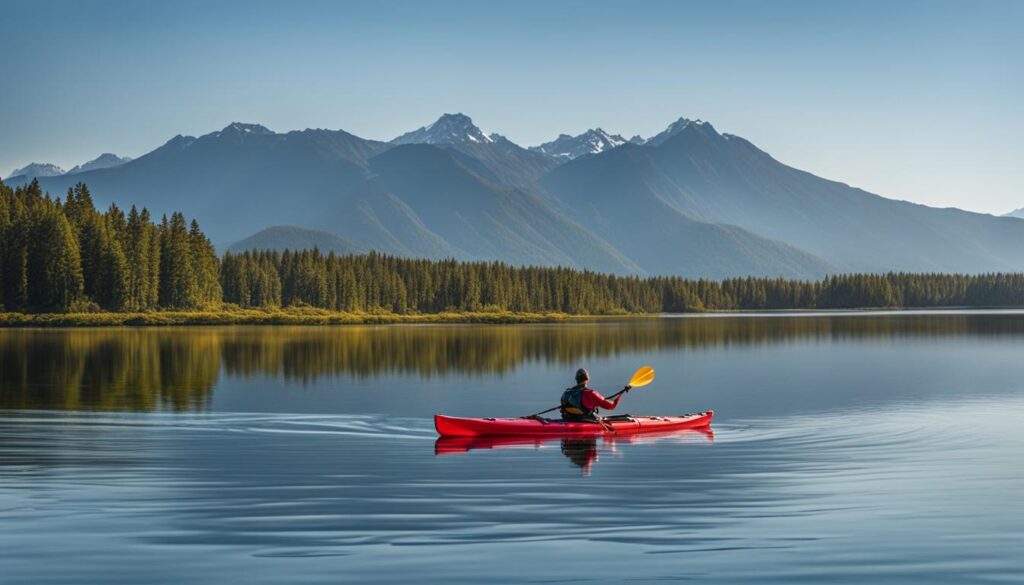
Remember, the key to a successful long-distance kayak trip is proper planning and preparation. Set realistic goals, consider the environmental factors, and gradually build up your endurance. By doing so, you can make the most of your kayaking adventures and enjoy the thrill of covering impressive distances.
Factors Affecting Kayak Distance: Weather Conditions
The wind and waves play a crucial role in determining the distance you can cover while kayaking. Understanding how these weather conditions affect your paddling can help you plan your trips more effectively and maximize your distance.
Wind and Kayak Paddling
Wind direction has a significant impact on kayak speed and distance. A tailwind, blowing from behind, can provide a helpful push, increasing your speed and allowing you to cover more ground effortlessly. On the other hand, a headwind, blowing against you, creates resistance and slows you down, making it harder to paddle forward.
Waves and Kayak Speed
The size and intensity of waves also affect your kayak’s speed and energy expenditure. Larger waves require more effort to paddle through, as you need to navigate through their peaks and troughs. This can slow down your overall speed and make it more challenging to cover long distances. In contrast, calmer water with smaller waves allows for smoother and faster paddling.
Optimizing Your Kayak Distance
When planning your kayak trips, it’s essential to consider the prevailing wind patterns and wave conditions. Choosing a route that aligns with favorable wind directions can help you take advantage of tailwinds and optimize your speed and distance. Similarly, selecting calmer water or sheltered areas can minimize the impact of waves and make your paddling experience more enjoyable.
By evaluating the weather forecast and considering wind and wave conditions, you can strategically plan your kayaking routes to ensure a smoother and more efficient paddling experience. Remember to always prioritize safety and adjust your plans accordingly if weather conditions become unfavorable.
Determining Distance Based on Kayak Type
When it comes to determining how far you can paddle in a kayak, the type of kayak you’re using plays a significant role. Factors such as weight and design can affect your speed and overall distance. Here are some key considerations for different kayak types:
Sit-on-top and sit-inside kayaks
Both sit-on-top and sit-inside kayaks are suitable options for long-distance paddling. Sit-on-top kayaks offer an open design that provides more comfort and flexibility. They are generally wider and more stable, making them a great choice for beginners. Sit-inside kayaks, on the other hand, provide more protection from the elements and are better suited for colder water conditions. They tend to be narrower and faster, making them ideal for experienced paddlers looking to cover greater distances.
Longer kayaks
Longer kayaks generally have higher maximum speeds but require more force to achieve and maintain those speeds. They provide better tracking and stability, making them a popular choice for long-distance trips. However, it’s important to consider your own comfort and paddling style when choosing a longer kayak. Longer kayaks may be less maneuverable and more challenging to transport compared to shorter ones.
Heavier kayaks
Heavier kayaks may have slower average speeds, but they offer greater stability, which can be beneficial in rough water conditions. They sit deeper in the water, which can provide a more comfortable and controlled paddling experience. However, it’s important to note that heavier kayaks can be more challenging to transport and require more effort to accelerate and maintain speed.
Ultimately, the best kayak for you will depend on your personal preferences and the type of paddling you plan to do. Consider factors such as comfort, stability, speed, and maneuverability when determining the distance you can cover with your kayak.
Planning Your Trip Distance
When preparing for a memorable kayak trip, one crucial aspect to consider is the distance you intend to cover each day. By planning your trip distance effectively, you can ensure a smooth and enjoyable journey. Several factors come into play when deciding how far you should paddle each day, including the water type, your experience level, weather conditions, and the overall length of your trip.
For beginners, it is recommended to start with a manageable distance of around 2-3 miles per day. This allows you to gradually build up your stamina and confidence on the water. As you gain more experience, you can increase the daily distance covered. However, it is important to strike a balance between challenging yourself and ensuring you have ample time for rest and exploration along the way.
During the planning process, it is crucial to research and choose appropriate paddling routes. Look for routes that offer a mix of natural hazards, scenic attractions, and established campsites. This way, you can enjoy the beauty of your surroundings while having access to necessary facilities and resources. Additionally, be sure to identify any potential obstacles along your chosen route, such as dams or low bridges, and plan accordingly.
Remember, the purpose of your kayak trip is not only to cover a specific distance but also to immerse yourself in the beauty of nature and enjoy the experience. Take the time to plan your trip carefully, considering all the relevant factors, and you’ll be well-prepared for a fantastic adventure!
Table: Factors to consider when planning your kayak trip distance:
| Factors | Description |
|---|---|
| Water type | The type of water you’ll be paddling in, such as rivers, lakes, or oceans, can impact your overall speed and ease of navigation. |
| Experience level | Your level of experience and skill in kayaking can determine how comfortable you are with longer distances and more challenging conditions. |
| Weather conditions | Consider the forecasted weather conditions, including wind speed, direction, and potential storms, as they can greatly affect your paddling experience. |
| Scenic attractions | Choosing a route that offers beautiful natural scenery or points of interest can enhance your trip, allowing you to take breaks and enjoy the surroundings. |
| Established campsites | If you plan to camp along your route, ensure there are established campsites or suitable areas for pitching tents in proximity to your daily destinations. |
| Rest and exploration time | Factor in time for rest and exploration during each day of your trip to avoid fatigue and fully appreciate the natural wonders around you. |
Conclusion
After reading this article, you now have a comprehensive understanding of how to plan and estimate the distance for your kayak trips. By considering factors such as your physical fitness, kayak type, wind and wave conditions, and route selection, you can ensure a successful and enjoyable experience on the water.
Remember to start with manageable distances, especially if you’re a beginner, and gradually build up your endurance over time. Take into account the specific characteristics of your kayak, such as its weight and design, as these can impact the distance you can paddle comfortably.
Additionally, be mindful of weather conditions, particularly wind direction and wave conditions. Tailwinds can help propel you forward, while headwinds may slow you down. Opting for calmer weather conditions can enhance your paddling experience and allow you to cover greater distances.
Lastly, don’t forget to plan your route carefully. Consider the type of water you’ll be paddling on, your experience level, and the overall length of your trip. Take into account rest and exploration time, as well as potential obstacles like dams or low bridges. Researching routes that offer natural hazards, scenic attractions, and established campsites can further enhance your kayaking adventure.
FAQ
How do I estimate the distance I can paddle when kayaking?
You can estimate the distance by using the Effort measurement, which is calculated by multiplying your kayak’s speed in miles per hour (MpH) by a variable percentage based on effort level. Multiply your effort level by the number of hours you plan to paddle to determine the approximate distance.
What factors impact kayak speed and distance?
Factors such as wind direction, water conditions, kayak weight, and personal fitness level can all affect kayak speed and distance. Tailwinds and calm waters help with forward progress, while headwinds and waves create additional challenges. Heavier kayaks sit deeper in the water, impacting speed and stability.
How far can the average person kayak in a day?
The average person can kayak anywhere from 8 to 17 miles per day, depending on their physical condition and environmental factors. Wind, waves, and the type of water being paddled can impact these distances. It’s important to set realistic goals based on your own capabilities and the conditions you’ll be paddling in.
How do weather conditions affect kayak distance?
Wind and waves play a significant role in kayak distance. Tailwinds can help propel you forward and increase your speed, while headwinds create resistance and slow you down. Larger waves require more effort to paddle through. Choosing calmer weather conditions can optimize your paddling experience and allow you to cover greater distances.
Does the type of kayak affect the distance I can paddle?
Yes, the type of kayak you use can affect the distance you can paddle. Longer kayaks generally have higher maximum speeds but require more force to achieve and maintain those speeds. Heavier kayaks have slower average speeds but greater stability. Consider the specific characteristics of your kayak, including weight and design, when determining how far you can paddle.
How should I plan the distance for my kayak trips?
It’s recommended to start with a manageable distance, such as 2-3 miles per day for beginners. Factors such as water type, experience levels, weather conditions, and the length of the trip should all be taken into account. Plan for rest and exploration time, as well as potential obstacles. Research routes that offer natural hazards, scenic attractions, and established campsites to enhance your paddling experience.
How do I plan for kayak trip distances?
Planning and estimating the distance for kayak trips is crucial for a successful and enjoyable experience. Consider factors such as physical fitness, kayak type, wind and wave conditions, and route selection. By following the formulas and guidelines provided, you can plan your kayak trips with confidence. Start with manageable distances, build up your endurance, and make adjustments based on personal experience.

